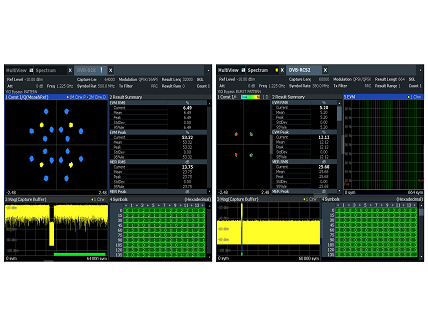
Rohde & Schwarz will showcase an end-to-end test infrastructure featuring its R&S SMW200A vector signal generator and R&S FSW signal and spectrum analyzer together with SatixFy’s Sx3099 modem ASIC demonstrating DVB-S2X Annex E wide bandwidth beam hopping and high bit rate DVB-RCS2 transmission.
Beam Hopping
Beam hopping provides a simple straightforward solution to the problem of adapting satellite resources to demand. It allows an increased aggregate capacity by plus 15 percent while reducing the unmet and excess capacity by 20 percent. The use of beam hopping is particularly appealing for future LEO constellations since it lowers on-board satellite power consumption, and it allows the implementation of half-duplex waveform to reduce user terminal costs and its power consumption as well. Rohde & Schwarz and SatixFy cooperate to develop test equipment and multi-beam SDR modem ASIC beam hopping ready, based on the DVB-S2X standard with DVB-S2X superframes and DVB-RCS2 waveforms.
SatixFy Israel, a company specializing in developing and selling SDR baseband chips, modems and electronically steered multi-beam antenna and Rohde & Schwarz, a leader in T&M solutions, are demonstrating during Satellite 2023 Show the wideband 1000 MHz DVB-S2X software defined radio (SDR) modem ASIC equivalent to 8 VSAT modems in a single chip in a common test setup.
The Sx3099 chip from SatixFy sets a record in terms of throughput exhibiting 1 Gsymb/s DVB-S2X beam hopping traffic in forward direction and 400Msymb/s throughput in RCS2, or 1 Gsymb/s in S2X in the return direction. The new wideband SDR modem is the only one in the market today supporting beam hopping (DVB-S2X Annex E Rev 2019) and VLSNR capable of multi-beam receive and transmit to support “make before brake” handover in LEO aero connectivity. The chip includes all the new superframe format types 5, 6 and 7 (pre-scheduled and “point and shoot” beam hopping). Sx3099 includes native support for DVB-RCS2 400 MHz transmission as well as complete software defined radio (SDR) for any other waveform.
The new modem’s multiple carriers beam hopping architecture (up to 4) enables substantially higher throughput from wideband (1GHz) satellite service to increase superior connectivity. The chip operates in VLSNR modes down to -10dB SNR and proprietary ELSNR modes (extremely low SNR) down to -20dB SNR and interfaces smoothly to SatixFy’s electronically steered antenna to operate 8 beams simultaneously over a single Sx3099 through a single ethernet port, for both data and control.
The R&S SMW200A and the signal and spectrum analyzer R&S FSW support the standard DVB-S2 / DVB-S2X with its latest version and with newly added annex E for beam hopping and the DVB-RCS2 standard as being used in upcoming LEO constellations. The R&S SMW200A vector signal generator is the first fully calibrated wideband solution with a bandwidth extension to an RF modulation bandwidth of 4 GHz and a signal generation across all frequencies and satellite bands up to 67 GHz on the market while the R&S FSW covers frequencies up to 90 GHz.
The DVB-S2X beam hopping demonstration is setup by the high-end vector signal generator R&S SMW200A providing a 500 MS/s DVB-S2X beam hopping signal with superframe 6 format on the forward downlink to the SatixFy Sx3099 SDR modem on the satellite IF of 1.225 GHz. The return uplink from the modem is modulated with a 380 MS/s wide DVB-RCS2 signal which is transmitted to the spectrum and signal analyzer R&S FSW. With the unique onboard DVB-RCS2 tool it is possible to analyze the spectrum and the signal quality with its content and also to decode the DVB-RCS2 signal.
The beam hopping demonstration can be experienced at the Satellite Show 2023 in Washington from March 14 to 16 at the Rohde & Schwarz booth 1326.
SatixFy is located at booth 2221 and looks forward to a further discussion on the Sx3099 chip.
To learn more about beam hopping and the support given to it by the standard please see
Beam Hopping maturing the technology


















